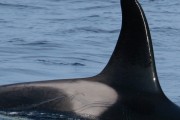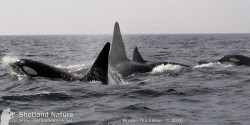Even as this year draws to a close there have been Killer Whale sightings around Shetland. So it seems like a good time to look back at the comings and goings of our Killer Whales during 2010.
The first whales showed up in late March (23rd) in Yell Sound, which is consistent with the past few years. We got a chance to photograph them from the Yell Sound ferry, but the sun was working against us and the images were backlit and we couldn’t really positively ID any of the whales. One of the female-sized fin silhouettes however had two distinctive notches in the trailing edge, which looked very much like the female with ID number 12. But other individuals had silhouettes that did not match any of the fins in our photo-id catalogue, and so it seems like we had some new whales!
The new individuals appeared to stick around for a couple of weeks as the fin shapes match with those seen hunting in Scalloway harbour only days later on the 28th March and with 2 males photographed in Yell Sound on the 8th April.
May was a quiet month around Shetland, and all the action was further south. The group of four (27, 34, 72 & 73) that are regularly seen around Shetland showed up in Scapa Flow in Orkney (6th May) and they had a new calf! It appears as though 27 is it’s mum as it stayed closest to her in all the photos we were sent. The photo (above) of this pod was taken on Bluemull Sound on 15/03/08.
We got to follow this group's travels through a series of great photos provided by the public. On the 13th May they were seen off Durness in Sutherland, but they headed east again and were photographed on the 20th off Whaligoe steps, Ulbster, Caithness. They didn’t show up again until 23rd August when they were photographed off the Faeroes feeding on eiders and doing some hunting training with the youngsters, and even hit the headlines by making it on to the Faeroese evening news.
12 and her group were also sighted regularly in May, being photographed between Shapinsay and Kirkwall in Orkney on the 9th May, and then Duncansby Head, Caithness on 16th. They were back up to Orkney where they took a marine mammal in Eynhallow Sound on the 25th May, before heading south again, being seen back off Caithness on the 28th May. Then they headed west and were last positively identified off St Kilda on 12th June. They may have also paid a fleeting visit to Shetland as a group that looked like them were photographed on 8th July off Bressay, but it was choppy weather and the photos weren’t clear enough to be sure.
Larger groups of Killer Whales were also getting seen feeding on herring offshore about 25 miles east of Shetland during May. Photos we received were all of individuals not previously catalogued.
June was pretty quiet too, until on the 23rd a group of 5 showed up in Yell Sound and took either a seal or porpoise just off the ferry. This was the start of an unprecedented run of sightings from the Yell Sound ferry, with almost daily sightings for a month. Photos that we have received or collected ourselves between 23rd June and 24th July showed that most of these sightings were of the same group of 5, which were positively IDed on the 23rd June, 7th, 12th, 15th and 18th July. The group had not previously catalogued and it seems highly likely that they are newcomers to Shetland.
Further south again, photographs came in of the group with female with ID number 15 (who we last saw in 2009 off Bluemull Sound). They were seen once off the Moray Firth on 29th June and then off Orkney on 20th July.
So, this year due to the amazing public contribution of photos, we’ve been able to track some pods as they have moved over quite a considerable distance, we’ve been able to monitor the birth of new calves, and we’ve seen what look like 2 sets of newcomers to the Northern Isles, suggesting that Killer Whale sightings in this area may be on the increase.
A massive thank you to everyone who contributed to this year’s efforts, the support continues to grow each summer!
Read more about the ID project at www.northatlantickillerwhales.com
This blogpost has also been published on www.shetlandnature.net - we would welcome further shared blogposts if they cover subjects of broad interest.














